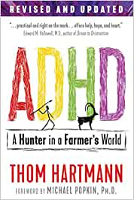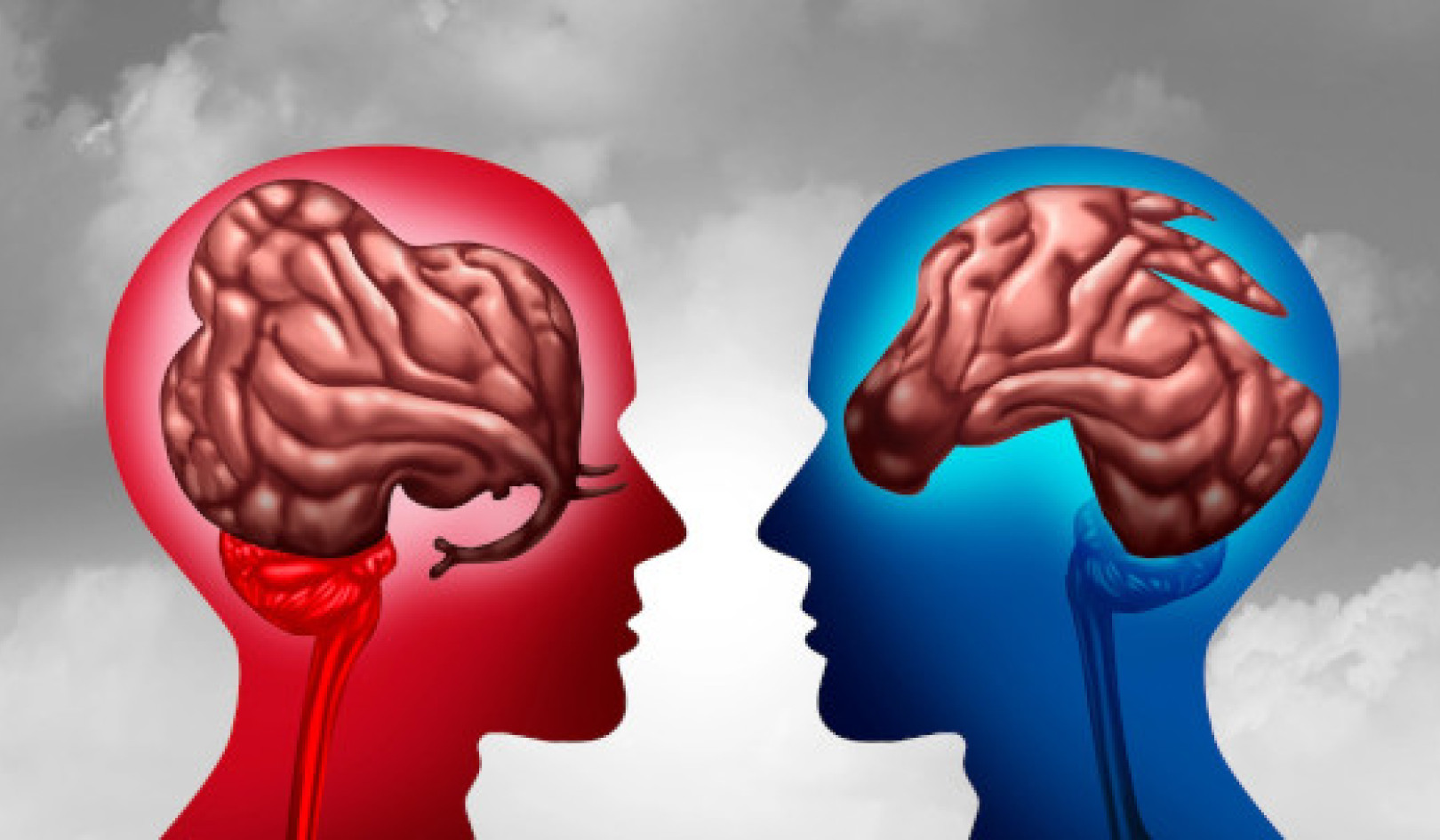
Image by khamkhor
ADHD is not an all-or-nothing diagnosis. There appears to be a curve of behaviors and personality types, ranging from extremely non-ADHD to extremely ADHD. Although there has not yet been enough research in the field to know the shape of this curve, it probably resembles a bell curve, with the majority of “normal” individuals falling somewhere in the center, showing a few ADHD-like characteristics, and a minority (perhaps somewhere around 20–30 percent of the population) being split up on the two extreme ends of the spectrum.
Since a large body of research indicates that ADHD is a hereditary condition, the distribution of this curve may well reflect the intermixing over the years of the genetic material of ADHD and non-ADHD individuals, blurring the edges of both types of behaviors. Placed along the spectrum of ADHD individuals you will find people who typically exhibit some or all of the following characteristics:
• Easily distracted
ADHD people are constantly monitoring the scene; they notice everything that’s going on, and particularly notice changes or quickly changing things in their environment. (This is the reason why, for example, it’s difficult to have a conversation with ADHD people when a television is on in the room; their attention will constantly wander back to the television and its rapidly changing inputs.)
• Short, but extraordinarily intense, attention span
Oddly enough, this isn’t definable in terms of minutes or hours: some tasks will bore an ADHD person in thirty seconds; other projects may hold their rapt attention for hours, days, or even months. ADHD adults often have difficulty holding a job for an extended period of time, not because they’re incompetent but because they become bored. Similarly, ADHD adults often report multiple marriages, or “extremely intense, but short” relationships. When tested for attention span on a boring, uninteresting task, ADHD people tend to score significantly lower than others.
• Disorganization, accompanied by snap decisions
ADHD children and adults are often chronically disorganized. Their rooms are a shambles; their desks are messy; their files are incoherent; their living or working areas look like a bomb went off. This is also a common characteristic of non-ADHD people, possibly related to upbringing or culture, but something usually separates messy ADHD folks from their non-ADHD counterparts: non-ADHD people can usually find what they need in their messes, while ADHD people typically can’t find anything.
An ADHD person may be working on a project when something else distracts him, and he makes the snap decision to change priorities and jump into the new project—leaving behind the debris from the previous project. One ADHD adult commented that, “The great thing about being disorganized is that I’m constantly making exciting discoveries. Sometimes I’ll find things I didn’t even know I’d lost!”
• Distortions of time-sense
Most non-ADHD people describe time as a fairly consistent and linear flow. ADHD individuals, on the other hand, have an exaggerated sense of urgency when they’re on a task, and an exaggerated sense of boredom when they feel they have nothing to do.
This sense of boredom often leads to the abuse of substances such as alcohol and drugs, which alter the perception of time, whereas the sense of fast time when on a project leads to chronic impatience. This elastic sense of time also causes many ADHD adults to describe emotional highs and lows as having a profound impact on them. The lows, particularly, may seem as if they’ll last forever, whereas the highs are often perceived as flashing by.
• Difficulty following directions
This has traditionally been considered a subset of the ADHD person’s characteristic of not being able to focus on something they consider boring, meaningless, or unimportant. While receiving directions, conventional wisdom has it that ADHD people are often monitoring their environment as well, noticing other things, thinking of other things, and in general, not paying attention. In other words, ADHD people frequently have difficulty following directions, because the directions weren’t fully received and understood in the first place.
Another theory to explain this is that ADHD people are very independent and tend to dislike being told what to do. They prefer to think for themselves and may therefore place less importance on others’ directions.
But the most likely explanation for this, according to some authorities in the field, is that people with ADHD have difficulty processing auditory or verbal information.
Converting Auditory Information to Visual Information
When you say to a “normal” person, “Go to the store and pick up a bottle of milk, a loaf of bread, and some orange juice, then stop at the gas station and fill up the car on the way home,” the “normal” person will create a mental picture of each of those things as she hears them described. She pictures the store, the milk, the bread, the juice, and the gas station. This congruence of verbal and visual images makes for high-quality memory.
But an ADHD person may only hear the words—without -creating the mental pictures so vital to memory. She drives off to the store, repeating to herself, “Milk, bread, juice, gas; milk, bread, juice, -gas . . .” until something distracts her and she loses the entire memory.
This problem with auditory processing is fairly well documented among children with ADHD. However, the percentage of its prevalence among the general, non-ADHD population is unknown. It may be that ADHD people are only slightly more likely to have this problem, or it may be a cardinal symptom or problem.
One ADHD adult described it this way: “I find my comprehension of long chains of words is improved, vastly, by a picture. That way my brain can directly absorb the pattern. If you unpattern it and translate it into a linear string of words, then I’m forced to absorb the string and reconstruct the pattern.”
This may also account for the so-very-common reports from parents of ADHD children that their kids are television addicts and hate to read. Reading requires the processing of auditory information (words sounded out within the brain into internal pictures), whereas television is purely external visualization. At the residential treatment facility I ran in New Hampshire, we found it useful to remove the televisions altogether from the residences of ADHD children. After a few months, the kids began reading, and the habit persisted after the reintroduction of television.
There’s also a debate about the cause of the connections between ADHD and the auditory-processing problem.
One camp says that it’s the result of a hardwiring problem in the brain—the same miswiring problem that causes other ADHD symptoms.
The other camp theorizes that converting auditory information to visual information is a learned behavior, acquired by most people about the time they become proficient with language, between ages two and five. Because ADHD people “weren’t paying attention,” they may be more likely to have simply missed out on learning this vital skill.
Since the skill of converting words to pictures can be taught to ADHD people with relative ease, the latter theory appears probable. Just say to an ADHD child, “Will you please visualize that?” and watch for the characteristic movement of their eyes toward the ceiling, which usually means they’re creating an internal mental image. If this is done each time instructions are given to an ADHD child, eventually (often in a matter of weeks) the child will learn this basic skill of auditory processing and it becomes second nature. (For ADHD adults, Harry Lorayne’s Memory Book is wonderful, with its heavy emphasis on several methods to teach this skill, along with what Lorayne calls “original awareness,” which is merely a painless method of teaching yourself to pay attention.)
• Exhibit occasional symptoms of depression, or daydream more than others
ADHD individuals who are relatively self-aware about the issues of sugar and food metabolism often report that depression or tiredness follows a meal or the consumption of sugary foods. This reaction may be related to differences in glucose (sugar) metabolism between ADHD and non-ADHD people.
Another possibility is that ADHD people are simply bored more often by the lack of challenges presented by our schools, jobs, and culture, and this boredom translates for some people into depression.
• Take risks
ADHD individuals seem to have strong swings of emotion and conviction, and make faster decisions than non-ADHD types. While this trait often leads to disaster (I’ve spoken with several psychiatrists who suggest that, in their experience, American prison populations may be up to 90 percent ADHD), it also means that ADHD individuals are frequently the spark plugs of our society, the shakers and movers, the people who bring about revolution and change. ADHD expert Dr. Edna Copeland, in a 1992 Atlanta speech I attended, referenced a recent study that indicates that about half of all entrepreneurs test out as being ADHD.
Evidence is strong that many of our Founding Fathers were also ADHD. If they hadn’t been, the United States of America might never have come into being. ADHD risk takers may have predominated in the early Americas because those were the people best suited to undertake the voyage to this continent and face the unknown.
• Easily frustrated and impatient
To “not suffer fools gladly” is a classic ADHD characteristic. While others may beat around the bush, searching for diplomacy, an ADHD individual is most often direct, to the point, and can’t understand how or why such bluntness might give offense. And when things aren’t working out, “Do Something!” becomes the ADHD person’s rallying cry—even if the something is sloppy or mistaken.
Conditions That May Mimic ADHD, and Vice Versa
Several conditions may mimic certain characteristics of ADHD, -causing an inaccurate diagnosis. These include:
• Anxiety disorders
ADHD may cause anxiety when people find themselves in school, life, or work situations with which they cannot cope. ADHD differs from garden-variety anxiety disorder in that an anxiety disorder is usually episodic, whereas ADHD is continual and lifelong. If anxiety comes and goes, it’s probably not ADHD.
• Depression
ADHD may also cause depression, and sometimes depression causes a high level of distractibility that’s diagnosed as ADHD. Depression, however, is also usually episodic. When depressed patients are given Ritalin or other stimulant drugs, which seem to help with ADHD patients, depressed patients will often experience a short-term “high” followed by an even more severe rebound depression.
• Manic-Depressive Illness
Manic-depression, now generally called bipolar disorder, is not often diagnosed as ADHD because the classic symptoms of bipolar disorder are so severe. One day a person is renting a ballroom in a hotel to entertain all his friends; the next day he’s suicidal. Yet ADHD is often misdiagnosed as manic-depressive illness. A visit to any adult-ADHD support group usually produces several first-person stories of ADHD adults who were given high-dose lithium or some other inappropriate drug because their ADHD was misdiagnosed as manic-depressive illness.
• Seasonal Affective Disorder
This recently discovered condition appears to be related to a deficiency of sunlight exposure during the winter months and is most prevalent in northern latitudes. Seasonal affective disorder (SAD) symptoms include depression, lethargy, and a lack of concentration during the winter months. It’s historically cyclical, predictable, and is currently treated by shining a certain spectrum and brightness of light on a person for a few minutes or hours at a particular time each day, tricking the body into thinking that the longer days of spring and summer have arrived. Seasonal affective disorder is sometimes misdiagnosed as ADHD, and vice versa, but seasonality is its hallmark trait.
"As a physician I’ve worked among indigenous hunting societies in other parts of the world, from Asia to the Americas. Over and over again I see among their adults and children the constellation of behaviors that we call ADD.
Among the members of the tribes of northern Canada, such as the caribou hunters of the McKenzie Basin, these adaptive -characteristics—constantly scanning the environment, quick -decision-making (impulsiveness), and a willingness to take risks—-contribute every year to the tribe’s survival.
These same behaviors, however, often make it difficult for tribal children to succeed in Western schools when we try to impose our Western curriculum on them."
-- Will Krynen, M.D. (1985)
©1993, 1997, 2019 by Thom Hartmann. All Rights Reserved.
Reprinted with permission of the publisher, Healing Arts Press,
an imprint of Inner Traditions Inc. www.innertraditions.com
Article Source
ADHD: A Hunter in a Farmer’s World
by Thom Hartmann.
 In this updated edition of his groundbreaking classic, Thom Hartmann explains that people with ADHD are not abnormal, disordered, or dysfunctional, but simply “hunters in a farmer’s world.” Often highly creative and single-minded in pursuit of a self-chosen goal, those with ADHD symptoms possess a unique mental skill set that would have allowed them to thrive in a hunter-gatherer society. As hunters, they would have been constantly scanning their environment, looking for food or threats (distractibility); they’d have to act without hesitation (impulsivity); and they’d have to love the high-stimulation and risk-filled environment of the hunting field. With our structured public schools, office workplaces, and factories those who inherit a surplus of “hunter skills” are often left frustrated in a world that doesn’t understand or support them.
In this updated edition of his groundbreaking classic, Thom Hartmann explains that people with ADHD are not abnormal, disordered, or dysfunctional, but simply “hunters in a farmer’s world.” Often highly creative and single-minded in pursuit of a self-chosen goal, those with ADHD symptoms possess a unique mental skill set that would have allowed them to thrive in a hunter-gatherer society. As hunters, they would have been constantly scanning their environment, looking for food or threats (distractibility); they’d have to act without hesitation (impulsivity); and they’d have to love the high-stimulation and risk-filled environment of the hunting field. With our structured public schools, office workplaces, and factories those who inherit a surplus of “hunter skills” are often left frustrated in a world that doesn’t understand or support them.
Click here for more info and/or to order this book. Also available as an Audiobook and as a Kindle edition.
About the Author
 Thom Hartmann is the host of the nationally and internationally syndicated talk-show The Thom Hartmann Program and the TV show The Big Picture on the Free Speech TV network. He is the award-winning New York Times bestselling author of more than 20 books, including Attention Deficit Disorder: A Different Perception, ADHD and the Edison Gene, and The Last Hours of Ancient Sunlight, which inspired Leonardo DiCaprio’s film The 11th Hour. He is a former psychotherapist and founder of the Hunter School, a residential and day school for children with ADHD.
Thom Hartmann is the host of the nationally and internationally syndicated talk-show The Thom Hartmann Program and the TV show The Big Picture on the Free Speech TV network. He is the award-winning New York Times bestselling author of more than 20 books, including Attention Deficit Disorder: A Different Perception, ADHD and the Edison Gene, and The Last Hours of Ancient Sunlight, which inspired Leonardo DiCaprio’s film The 11th Hour. He is a former psychotherapist and founder of the Hunter School, a residential and day school for children with ADHD.
Visit his website: www.thomhartmann.com or his YouTube channel.






























